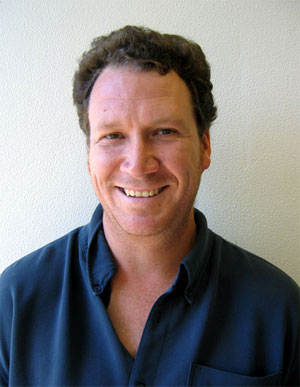GEMOC ARC National Key Centre
Dr Oliver Gaul
BSc (hons) Macq, PhD Macq
Research OfficerContact DetailsOffice : E7A 433 Dr Oliver Gaul |
 |
Profile
Oliver Gaul is a Research Officer in GEMOC. Oliver has completed a PhD examining the composition of the lithospheric mantle beneath Australia.
Fields of research
Thesis title: Composition of the Lithospheric Mantle beneath Australia
Supervisor: Professor S.Y. O'ReillyProject Outline
This project set out to characterise the structure and composition of targeted regions of the Australian lithosphere and particularly the lithospheric differences across tectonic domains of the continent. This is possible through the study of mantle derived xenoliths and xenocrysts which preserve equilibrium mantle conditions from depths of up to 200 km. These samples provide information which allows the construction of lithospheric sections at each sample locality. These lithospheric sections permit interpretation of the physical and chemical structure of the lithosphere in a spatial context based on a thermal framework.
Samples from three main areas in Australia have been studied:
1. Southern Australia.
A series of kimberlites stretching from Jugiong in southeastern NSW to the Eyre Peninsula in central South Australia (Figure 1) have allowed construction of a lithospheric transect in this area. This transect crosses the Tasman Line - which delineates the boundary between the Phanerozoic, accreted terrains of eastern Australia and the Archean and Proterozoic cratonic regions of central and western Australia. Results from the southern Australian localities were presented in a paper given at the American Geophysical Union's Western Pacific Geophysics Meeting in Brisbane in July 1996 (abstract).
2. The Kimberley Region.
Samples from three areas of kimberlites and lamproites in the Kimberley Region have been studied(Figure 1). These localities represent both the Archean/Proterozoic Kimberley Block and its surrounding Proterozoic mobile belts. A fourth locality from the Proterozoic of the Northern Territory has also been studied for comparison.
3. Northern Queensland.
The Tertiary and Quaternary basaltic volcanic provinces of Far North Queensland provide mantle xenoliths for study. These provinces straddle the Tasman Line and allow interpretation of changes in crustal thickness and mantle composition across the Tasman Line in this region.

Results from the southern Australian transect have shown increasing lithospheric thickness and cooler geotherms towards the cratonic areas of central Australia (Figure 2). The easternmost locality, Jugiong, has lithosphere of ~100 km thickness with a geotherm (>50 mWm-2) which is similar to the elevated southeastern Australian geotherm (O'Reilly and Griffin, 1985). At the western end of the transect the geotherm is more in line with standard cratonic geotherms (~40 mWm-2) and the lithosphere is around 160 km thick.

There is also an important change in the chemical composition of the lithospheric mantle along this transect (Figure 3). The localities at the western end of the transect are more depleted than those in the east. This reflects their depletion through extraction of basaltic material in the form of partial melts. The younger eastern lithosphere has not been subjected to this process to this degree and also appears to have been enriched in trace elements through metasomatism.
A further result from the study of mantle samples in southern Australia has been the indication of lithospheric thinning in the region. In central South Australia the Permian Springfield locality appears to have had a thicker lithosphere than that indicated by nearby Jurassic localities. From this it can be concluded that the lithosphere in this region was thinned (by between 10 and 15 km) between Permian and Jurassic times. The processes which caused this thinning are undetermined but a possible candidate is thermal erosion of the lithosphere due to heating associated with the breakup of Pangea.

Funding for this project was through an Australian Postgraduate Award (Industry) with generous assistance from Stockdale Prospecting Pty Ltd and the CSIRO. Samples were provided by Stockdale Prospecting Pty Ltd, CRA Exploration (now Rio Tinto) and Ashton Mining.
Publications
O'REILLY, S.Y., GRIFFIN, W.L. and GAUL, O. 1996. Paleogeothermal gradients in Australia: key to 4-D lithosphere mapping. AGSO Journal of Australian Geology and Geophysics, 17, 63-72.
GRIFFIN, W.L., O'REILLY, S.Y., RYAN, C.G., GAUL, O. and IONOV, D.A., 1998. Secular variation in the composition of subcontinental lithospheric mantle: geophysical and geodynamic implications in Structure and Evolution of the Australian Continent, J. Braun, J.C. Dooley, B.R. Goleby, R.D. van der Hilst and C.T. Klootwijk (eds). AGU Geodynamics Series, 26, 1-26.
Gaul, O.F., Griffin, W.L., O'Reilly, S.Y. and Pearson, N.J. 2000. Mapping olivine composition in the lithospheric mantle. Earth and Planetary Sciences, 182, 223-235.
Gaul, O.F., O’Reilly, S.Y. and Griffin, W.L. 2002. Lithosphere structure and evolution in southeastern Australia. Geological Society of Australia Special Publication, 22, 179-196.
Sidebar
Text
